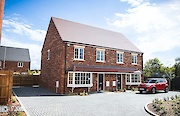


Head of Content

Mortgage Advisor & Director
Can you get a mortgage on a flat above a shop

In theory, yes. However, many lenders are cautious about these kinds of properties, as the perceived risk is higher. You will likely have less choice of mortgages available to you, compared to if you were buying a standard residential property. However, you will find lenders willing to offer both residential and buy-to-let for a flat above shop mortgage.
Getting a mortgage on a flat above a shop
Things like smells, high footfall from the public, and sharing access points with commercial premises can all mean that the property needs a higher level of maintenance and repair, and can be more prone to damage.
Even less tangible "damage" to the investment, such as noise or people loitering around at unsociable hours, can harm the resale value of the property. This puts the lender’s investment at risk, which is why they are so cautious.
What kinds of mortgage can I expect for a flat above a restaurant?
You will be able to find both residential and buy-to-let mortgages for this type of property. However, these kinds of property typically depreciate in value more quickly, so it’s likely that you will require a larger deposit to reduce the lender’s risk.
Not all lenders will consider this type of property, both because of the risk profile and because of the complexity of the application. It’s highly recommended to speak to a broker to secure the best deal and ensure you have the highest chance of your application being successful.
What affects the lender’s decision in a mortgage application for flats above restaurants?
The lender will assess the property very carefully when making their decision. Things like the layout of the flat will make a difference, as well as any shared entrance points with the restaurant. The type of restaurant will also affect the likelihood of your application being accepted - a lunchtime cafe serving sandwiches may be more attractive than a late-night takeaway company.
The lender will need to know the designated business category of the restaurant. Business categories A3-A5 tend to be of the greatest concern to lenders, due to noise, smells, late hours, increased fire risks, and the social issues associated with venues serving alcohol. The category of the business will affect whether they decide to lend at all, as well as the Loan to Value (LTV) rate they are willing to offer. For flats above restaurants, the absolute maximum is likely to be 75%, with many people finding they are offered less than this.
Business categories:
- Category A1:
Includes general stores such as food shops and newsagents - Category A2:
Covers professional services like banks and estate agents - Category A3:
Restaurants, cafes, food and drink establishments - Category A4:
Pubs, bars and other drinking establishments - Category A5:
Hot food takeaway outlets
What about BTL (buy to let) mortgages specifically?
Restaurants are usually situated in central, busy areas, which can make them great locations for a certain type of renter. Young professionals who want to live close to nightlife or work may view living "in the centre of the action" as very attractive, and be less bothered by smells or late night noise than a family with young children. Due to the appeal to these kinds of locations, as long as you meet the lender’s criteria, they won’t be averse to considering the potential rental income of a property like this.
BTL mortgages generally require larger deposits and offer you higher interest rates. Affordability checks may be tougher, as they’ll need to know you can cope with mortgage payments even if the property is untenanted for a period.
Choosing an Adviser
Selecting a qualified and experienced mortgage adviser is of great importance. To choose a suitable adviser, evaluate their qualifications, experience, and reputation, and ensure they are regulated by the Financial Conduct Authority (FCA).
Read reviews from previous clients and make sure they provide a clear explanation of the products and services they offer, as well as the fees and charges associated with them.


























































































































































